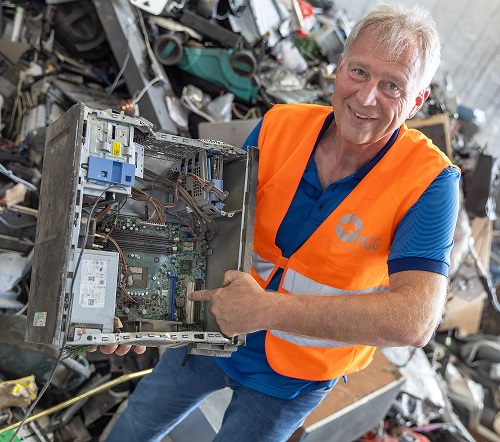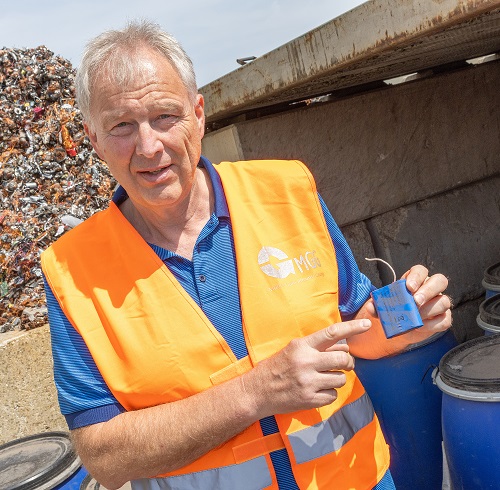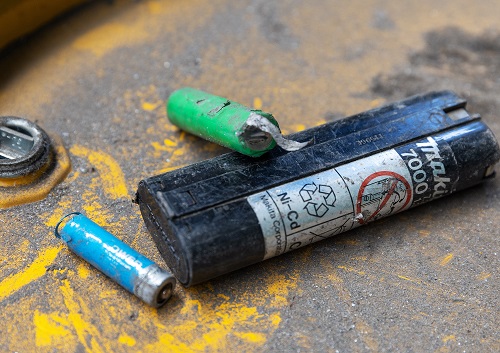Armin Blutsch, former vice-president of the Austrian Federal Fire Brigade Association and fire safety officer at MGG Metrec, is one of the country’s experts when it comes to fires and their extinguishing. His statement that „batteries and accumulators do not primarily catch fire through heat“ may be surprising, but it is a fact. Nevertheless, it happens again and again that batteries and accumulators start to burn. This has already happened on the factory premises of MGG Metrec. And trucks have also caught fire during the transport of e-wast. This is a danger that should not be underestimated.

Button batteries can be found in computers, for example, but also in children’s toys.
Electronic waste is delivered to MGG Metrec every day. Mixed metal and plastic fractions that are separated, shredded, temporarily stored and finally transported onwards at the plant. The e-waste consists of household appliances that are no longer functional, toys, tools, mobile phones and much more. Before disposal, batteries or rechargeable batteries are often not removed, and sometimes it is not even obvious that batteries are contained in the part to be disposed of. Batteries and rechargeable batteries thus end up with the e-waste in the separation facilities of a recycling company and thus become a potential source of danger.
In the first step, the delivered e-waste goes into the so-called smasher, where a large part of the batteries and accumulators – about 80 per cent – are sorted out. The remaining 20 per cent goes into the EVA shredder with the primary material. Some of it is still recognised and removed here, but the small batteries (for example button batteries on motherboards in computer cases) fall through every now and then. And it is precisely here that the hazard potential grows enormously.
Battery fires are almost exclusively caused by mechanical damage
„Mechanical impacts such as knocks, cracks or bends damage the small batteries, making them susceptible to malfunction. In addition, they are exposed to moisture outdoors. It is usually only a matter of time when – uncontrolled – a short circuit happens,“ Armin Blutsch explains the problem. „Batteries and rechargeable batteries have an enormous energy density. When a short circuit occurs, this energy is converted into great heat, which in turn ignites the adjacent material extremely quickly. The fire starts and escalates at lightning speed!“, says the fire protection expert. „Extinguishing a battery fire is impossible. Here, it is necessary to save the surrounding areas, which can be done most easily by keeping an appropriate distance from the source of the fire. The secret recipe is therefore: Distance! Distance! Distance!“

„The batteries are stored in these metal containers with sand until they are collected. If a battery should short out, it can burn out in there without much risk.“
At Metrec, these fire hazards are countered on various levels. Of course, the company relies first and foremost on technology: A fire protection or extinguishing system that meets the latest standards prevents worse in the event of an emergency. But the danger is averted much earlier. Great care is taken to ensure that scrap material is stored appropriately. The sorted batteries and accumulators are stored in barrels until they are collected by processing companies. A layer of batteries is followed by a layer of sand, etc., until the barrel is full. When sealing the barrels, care is taken to ensure that as little oxygen as possible is included. If a fire does occur, the sand acts as a resistance. Due to the lack of oxygen, the fire goes out very quickly.
An important precaution is that no e-waste is on conveyor belts or in machines when they are out of operation. This prevents damage to the plant and equipment in the event of a fire. However, the most essential component in fire prevention is people. Metrec therefore attaches great importance to the training of its employees.
If a fire does occur, which is rare but can happen, the smartest thing to do is to let batteries and accumulators burn out – controlled by the fire brigade – and make sure that the surrounding areas are secured and preserved. Either by keeping a distance or by extinguishing or cooling the surrounding area appropriately.

80% of the batteries are sorted out in the smasher, the remaining 20% end up in the EVA shredder with the primary material.
Practical tips from a professional
But it is not only in the recycling business that it is important to keep a watchful eye on batteries and accumulators, says Blutsch: „We handle these energy sources far too carelessly in everyday life. Just think of mobile phones, which we carry on our bodies almost all the time. As already mentioned at the beginning, heat, e.g. in summer, does not primarily trigger a battery fire. But if the mobile phone falls to the ground frequently and the battery is damaged, it can short-circuit at any time and catch fire. Blutsch therefore advises not to place mobile phones on a wooden plate for charging, but to use a base made of glass or ceramic for this purpose. Curtains or similar easily combustible materials should also not be in the vicinity – distance is also an important preventive measure here. But there are also numerous sources of danger in the cellar, garage, tool shed and even in the children’s room (!), such as batteries in toys, which should not be forgotten.

The shape and size of batteries and accumulators may vary, but they always remain an unpredictable charge of energy.
When disposing of a household appliance or toy that still contains rechargeable batteries, the expert asks for special care: „Every individual can help to minimise the risk of fire and explosion in the recycling chain by removing batteries and rechargeable batteries before disposal and sending them for separate collection. Sometimes there are also so-called „hidden“ batteries in the appliance. In this case, a second, controlling look at the goods to be disposed of helps. Under no circumstances should batteries and rechargeable batteries end up in the residual waste or in the yellow bag!“
The Müller-Guttenbrunn Group would not be so successful if the focus were not permanently on innovation and constant further development, and this is also the case with this topic. To the question: „What does the future hold in store in this case?“ Armin Blutsch immediately has an answer ready: „Batteries and rechargeable batteries are getting smaller and smaller in terms of dimensions, but the performance is getting bigger and bigger. As the power increases, so does the energy contained in the batteries and rechargeable batteries, which in turn increases their flammability and the resulting heat that is released in the event of a fire. A danger for Metrec, but also for every user of battery- and accumulator-powered devices. Let’s be mindful together and take precautions. The easiest way is to take the three most important measures: Distance! Distance! Distance!“
